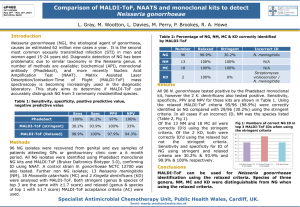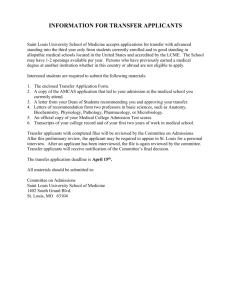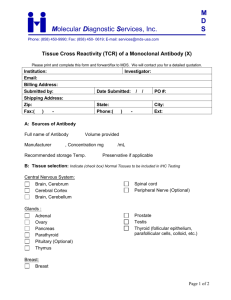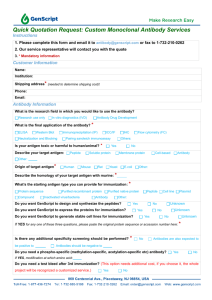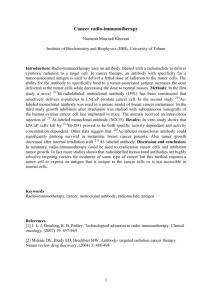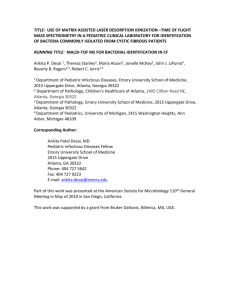to read the 2012 Winning Paper
advertisement
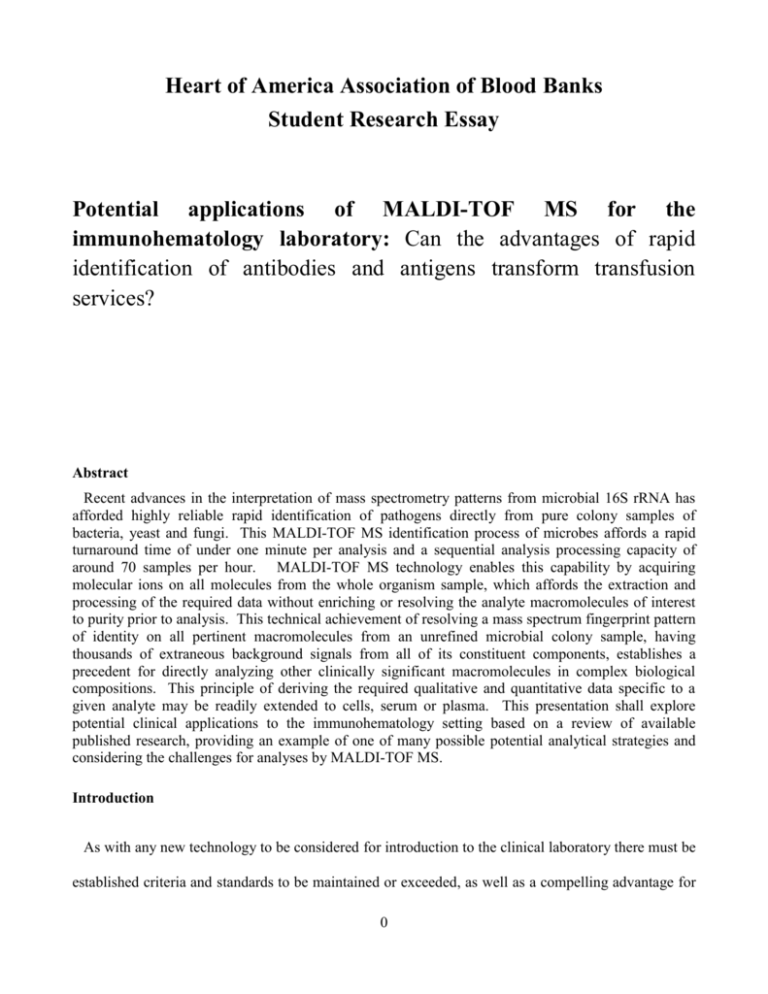
Heart of America Association of Blood Banks Student Research Essay Potential applications of MALDI-TOF MS for the immunohematology laboratory: Can the advantages of rapid identification of antibodies and antigens transform transfusion services? Abstract Recent advances in the interpretation of mass spectrometry patterns from microbial 16S rRNA has afforded highly reliable rapid identification of pathogens directly from pure colony samples of bacteria, yeast and fungi. This MALDI-TOF MS identification process of microbes affords a rapid turnaround time of under one minute per analysis and a sequential analysis processing capacity of around 70 samples per hour. MALDI-TOF MS technology enables this capability by acquiring molecular ions on all molecules from the whole organism sample, which affords the extraction and processing of the required data without enriching or resolving the analyte macromolecules of interest to purity prior to analysis. This technical achievement of resolving a mass spectrum fingerprint pattern of identity on all pertinent macromolecules from an unrefined microbial colony sample, having thousands of extraneous background signals from all of its constituent components, establishes a precedent for directly analyzing other clinically significant macromolecules in complex biological compositions. This principle of deriving the required qualitative and quantitative data specific to a given analyte may be readily extended to cells, serum or plasma. This presentation shall explore potential clinical applications to the immunohematology setting based on a review of available published research, providing an example of one of many possible potential analytical strategies and considering the challenges for analyses by MALDI-TOF MS. Introduction As with any new technology to be considered for introduction to the clinical laboratory there must be established criteria and standards to be maintained or exceeded, as well as a compelling advantage for 0 justifying a transition to it. In the case of MALDI-TOF MS for clinical microbial identifications, the substantially shortened turnaround time improves the quality while also reducing the cost of medical care. In addition the reduced clinical lab costs associated with performing microbial culture identifications are compelling. This is realized by decreased consumable usage associated with selective medias and biochemical testing, as well as reduced personnel times, which is significant with each clinical sample processed. The high capital costs associated with the initial investment for a MALDI-TOF MS system can steadily be recovered over time, and for labs providing a high volume of services this can be recouped relatively quickly since this method entails nearly negligible consumable costs. MALDI-TOF MS is adaptable to a wider range of analytical applications, as evidenced by the expansive array of practices in the research community. Another clinical setting that is highly sensitive to turn-around time is the immunohematology and transfusion services laboratory, where providing the highest quality blood products in the shortest possible time, especially for the patient whom is in critical need. The blood bank team strives to type and crossmatch blood units in one hour upon submission of STAT orders, which can be accomplished if the recipient’s antibody screen is negative. However, a recipient with a positive antibody screen may require up to three hours turn-around time when one antibody is encountered and possibly far longer for cases complicated with multiple antibodies (Siegel 2001). The pertinent potential MALDI-TOF MS applications for immunohematology would be the identification of protein, glycoprotein, or glycolipid antigenic epitopes, as well as the corresponding paratopes of clinically significant antibodies. Gleaning multiple clinical analyte assessments from a single assay determination is a strong possibility, having been accomplished by the GC/MS assay of urine samples from newborns to screen for over 40 heritable defects in metabolism from one analysis (Shoemaker 2010). Further proof-of-principle has been established by the MALDI-TOF MS identification of clinical microbes where multiple macromolecular elements provide a signature 1 spectrum profile from analysis of an untreated colony (Seng 2009), which has been found to be reproducible between published studies (Clarridge III 2004) and is comparable between currently available commercial systems (Martiny 2012). Transposing this concept to the blood bank would offer the same advantages that the clinical microbiologist can now realize. Looking five years into the future, suppose that for a negligible cost and less than an hour from receiving a sample in the lab that: 1) A single analysis of the recipient’s plasma provides identification of 26 antibodies to… D, C, c, E, e, Cw, f, V, K, k, Kpa, Kpb, Jsa, Jsb, Jka, Jkb, Fya, Fyb, Lea, Le b, M, N, S, s, P1, and Xga 2) A second analysis of the recipient’s RBCs provides identification of 26 antigens to those same corresponding antigens… D, C, c, E, e, Cw, f, V, K, k, Kpa, Kpb, Jsa, Jsb, Jka, Jkb, Fya, Fyb, Lea, Le b, M, N, S, s, P1, and Xga Also envision that every blood unit provided from the regional blood collection and distribution service has characterized these same antigens, allowing the best possible compatibility profile between the donor and recipient. Hence, in a very short time these two MALDI-TOF MS analyses provides 1) an antibody screen, 2) a comprehensive antibody panel, 3) an antigen panel of the recipient, and 4) a best-fit compatibility match with the available donor units either on hand in the blood bank or locally from the Red Cross. The present state of the art for transfusion services is to focus on the existing antibody profile of the recipient at the time of each transfusion, which is satisfactory when a patient only has an allogenic exposure once in a lifetime. However, in the case of patient’s that are repeatedly challenged with multiple sequential allogenic challenges from periodic transfusions the risk of inducing an immune response escalates due to incompatible antigenic exposures. In these cases, better crossmatching of antigen profiles between donor units and recipients is essential to improve a patient’s long term health. While a perfect crossmatch is not attainable, avoidance of the exposure to the higher risk antigens may be feasible a feasible goal. Discussion 2 Principle of MALDI-TOF MS analysis. Matrix Assisted Laser Desorption & Ionization (MALDI) is a soft ionization technique for charging whole macromolecules (M + H) +, yielding an identifiable mass to charge (m/z) parent ion. This is accomplished by the interaction of the sample molecules cocrystallized on a solid surface as a matrix with organic acids having extended conjugated double-bonds that readily absorb ultraviolet (UV) laser energy and in turn ionize the macromolecules. The UV laser energy vaporizes this matrix into a cloud as it is desorbed from the solid-phase surface, and simultaneously ionizes the analyte that is then directed into the Time-of-Flight (TOF) mass spectrometer (MS). Presently available instrument specifications offer a broad mass spectrum range of up to 500 kilo-Daltons at high signal resolutions of >5,000 Full Width at Half Maximum (FWHM) of m/z peak heights. Each molecule will have a family of peaks that are natural abundance isotopologues due to the native incorporation of H2, C13, N15, O18, S33 and S34 stable isotopes, with each stable mass combination having its own unique m/z peak; as in the example of a proteolytic peptide fragment of ACTH, Figure 1. The analytical sensitivity is extremely high, requiring only about a g of whole sample and matrix to be spotted on the plate for analysis. With each analysis the amount of each analyte desorbed from the plate by the UV laser and directed into the TOF MS is at the 100 to 500 attomole or 10-18 mole range. MALDI-TOF MS provides absolute identification specificity for each analyte, which can be compared to a spectral reference library. Identification of antigens is often complicated by their discontinuous composition. Most antigens, as in the example of the epitopic determinants for Thrombin (illustrated in red segments in Figure 2) were mapped by investigators (Baerga-Ortiz 2002). The mapping of these amino acid sequences were determined by applying a simple stable isotope exchange labeling technique in conjunction with MALDI-TOF MS analysis. Exchangeable labile hydrogens within an epitope determinant sequence offer an opportunity for binding detection. 3 Exchangeable labile hydrogens within an epitope determinant sequence. Labile hydrogens offer an opportunity for exchange labeling with deuterium from deuterium oxide, also known as deuterated water or heavy water (H2O or D2O). During the initial labeling step in deuterium oxide buffers a free exchange between deuterium and hydrogen occurs on primary amines, carboxylate or hydroxyl functional groups of the amino acids comprising peptides and proteins; as illustrated in Figure 3 for aspartic acid’s carboxylic acid proton in the partial epitope determinant sequence –KLKKPVAFSDY– for thrombin. Binding by an antibody, binding protein or ligand protects these deuterated functional groups from re-equilibrating with water, Figure 4. Antibody binding to a protein epitope having a labeled deuterium amino acid sequence excludes solvent access to the site of interest, preventing deuterium labeled positions from re-exchanging with water when diluted with aqueous buffers. These protected deuterated amides from antibody binding retain an enriched mass shift in their parent ions as detected by MALDI-TOF MS spectra, Figure 5. This analytical strategy can be applied to the detection of antigenic determinants, antibody paratopes, or any case where detection of specific binding to a protein is required. In the context of compatibility testing either defined reagent antigens are used to ascertain the presence of plasma antibodies Figure 6; or vice versa, reagent antibodies complex with the recipient or the donor unit antigens. Conclusion Precedence has been established for acquiring highly specific and clinically significant analytical information from a crude biological sample with the advance of informatics data processing of MALDI-TOF MS analytical data for clinical microbiology testing. This ability of MALDI-TOF MS to provide the proper identification of over 1,600 microbial pathogenic species from a single unprocessed cultured colony has begun a new era for improving microbiology diagnostics (Seng 2009). 4 In recent years intensive research has identified numerous biomarkers of clinical interest that are amenable to MALDI-TOF MS, which are cited in a review article (Hortin 2006). In some cases antigen-antibody complexes can be selectively enriched before analysis to exclude interfering molecules, for example by using magnetic beads coated with a hydrophobic phase (MB-C8 Magnetic Beads, Bruker Daltonics, Leipzig, Germany) (Zhang 2004) or by selective size retention using Nanotraps® acrylic acid bait bead technology (Ceres NanoSciences, Manassas, VA). These examples are just a few of many straightforward steps that may, or might not; require a modest investment in time and materials before MALDI-TOF MS analysis. The example provided that demonstrates binding between an antibody and the protein thrombin, (Baerga-Ortiz 2002) based on protection of deuterium labeled positions is a simple and cheap technique costing only about 4 cents for a 50 L analysis sample (Sigma Aldrich, Saint Louis MO; deuterium oxide #151882 - 100 grams, $89). The cost of MALDI-TOF MS analysis represents such a major savings in reagents, given a sample throughput of only 100 assays per day, it will pay for itself in consumable savings alone in less than two years at present capital expenditures. As the technology expands and competition increases beyond the only two present vendors this capital cost should recede significantly. For each potential application some technical challenges will be encountered, but given the advances in all the relevant technologies these method developments and transitions should be manageable. Given a commitment to research and development, in a relatively short time the advantages of a comprehensive antibody and antigen profiling of all transfusion recipients and donor units by MALDI-TOF MS could become a reality. References Baerga-Ortiz, Abel, Carrie A. Hughes, Jeffrey G. Mandell, And Elizabeth A. Komives. "Epitope mapping of a monoclonal antibody against human thrombin by H/D-exchange mass spectrometry 5 reveals selection of a diverse sequence in a highly conserved protein." Protein Science (The Protein Society, Cold Spring Harbor Laboratory Press) 11 (2002): 1300 – 1308. Clarridge III, Jill E. "Impact of 16S rRNA Gene Sequence Analysis for Identification of Bacteria on Clinical Microbiology and Infectious Diseases." Clinical Microbiology Reviews 17, no. 4 (October 2004): 84 0– 862. Hortin, Glen L. "The MALDI-TOF Mass Spectrometric View of the Plasma Proteome and Peptidome." Clinical Chemistry (American Association for Clinical Chemistry) 52, no. 7 (April 2006): 1223 – 1237. Martiny, Delphine, Laurent Busson, Ingrid Wybo, Rachid Ait El Haj, Anne Dediste and Olivier Vandenberg. "Comparison of the Microflex LT and Vitek® MS systems for the routine identification of bacteria by Matrix-Assisted Laser Desorption-Ionization Time-Of-Flight Mass Spectrometry." Journal of Clinical Microbiology (American Society for Microbiology) published online ahead of print (February 2012). Seng, Piseth, Michel Drancourt, Fre´de´ rique Gouriet, Bernard La Scola, Pierre-Edouard Fournier, Jean Marc Rolain and Didier Raoult. "Ongoing Revolution in Bacteriology: Routine Identification of Bacteria by Matrix-Assisted Laser Desorption Ionization Time-of-Flight Mass Spectrometry." Clinical Infectious Diseases (Infectious Diseases Society of America) 49, no. 4 (2009): 543 – 551. Shoemaker, James D. "One-step Metabolomics: Carbohydrates, Organic and Amino Acids." 2010. http://www.jove.com/index/Details.stp?ID=2014. Siegel, Don L. "Chapter 12: Pretransfusion Compatibility Testing, Section VI Turnaround Times, page 114." In Handbook of Transfusion Medicine, edited by et. al Christopher D. Hillyer. Academic Press, 2001. Sza´jli, Emília, Tama´ s Fehe´r, and Katalin F. Medzihradszky. "Investigating the Quantitative Nature of MALDI-TOF MS." Molecular & Cellular Proteomics (American Society for Biochemistry and Molecular Biology) 7 (December 2008): 2410 - 2418. Zhang, Xinyi, Sau-Mei Leung, Claudia R. Morris, and Mark K. Shigenaga. "Evaluation of a Novel, Integrated Approach Using Functionalized Magnetic Beads, Bench-Top MALDI-TOF-MS with Prestructured Sample Supports, and Pattern Recognition Software for Profiling Potential Biomarkers in Human Plasma." Journal of Biomolecular Techniques (Association of Biomolecular Resource Facilities) 15, no. 3 (2004): 167 – 175. Acknowledgements A special thanks to the following for their helpful comments and suggestions: 6 Angela C. Njoku MS, MT (ASCP). Director, Clinical Laboratory Technology Program, Saint Louis Community College at Forest Park, Saint Louis MO. Robin R. Chamberland Ph.D. Director, Microbiology Laboratory Saint Louis University Hospital; Assistant Professor, Department of Pathology Saint Louis University School of Medicine, Saint Louis MO. Mary M. Mayo, Ph.D. DABCC, NRCC, MT (ASCP) Director, Clinical Chemistry Laboratory Saint Louis University Hospital; Associate Professor, Department of Pathology Saint Louis University School of Medicine, Saint Louis MO. James Shoemaker, M.D. Associate Professor, Director, Metabolic Screening Lab, Department of Biochemistry and Molecular Biology, Saint Louis University School of Medicine, Saint Louis MO. Figure 1) Natural Abundance Isotopologues due to Native H2, C13, N15, O18, S33 or S34 Stable Isotope Combinations. 7 (M + H)+ parent ion with C13 with O18 with N15 & O18 with C13, N15 & O18 with C13, O18 & S34 Figure 2) Mapping of Binding Epitopes on Thrombin 8 Figure from: Baerga-Ortiz, Abel, Carrie A. Hughes, Jeffrey G. Mandell, And Elizabeth A. Komives. "Epitope mapping of a monoclonal antibody against human thrombin by H/D-exchange mass spectrometry reveals selection of a diverse sequence in a highly conserved protein." Protein Science (The Protein Society, Cold Spring Harbor Laboratory Press) 11 (2002): 1300 – 1308. Figure 3) 9 Exchangeable Labile Hydrogens within an Epitope Determinant Sequence Ser -KLKKPVAFSDYLabile H 1 A = Alanine 0 1 D = Aspartic acid (COOH) 1 1 F = Phenylalanine 0 3 K = Lysines (NH2) 3 1 L = Leucine 0 1 P = Proline 0 1 S = Serine (C-OH) 1 1 V = Valine 0 1 Y = Tyrosine (C-OH) 1 Tyr Ser OD D-O-D Tyr D-O-H Offer an Opportunity for Binding Detection Figure 4) 10 Antibody or Antigen Figure 5) Protected Deuterated Amides from Antibody Binding Retain an 11 Enriched Mass Shift as Detected by MALDI-TOF MS Spectra Parent ion Profile without Protection of Antibody or Antigen Binding Mass Shift due to Protection of Deuterium Label by Antibody or Antigen Binding Figure from: Baerga-Ortiz, Abel, Carrie A. Hughes, Jeffrey G. Mandell, And Elizabeth A. Komives. "Epitope mapping of a monoclonal antibody against human thrombin by H/D-exchange mass spectrometry reveals selection of a diverse sequence in a highly conserved protein." Protein Science (The Protein Society, Cold Spring Harbor Laboratory Press) 11 (2002): 1300 – 1308. 12 Figure 6) Antigen-Antibody Complexes Labeled with Deuterium as a Signal for Binding 13
